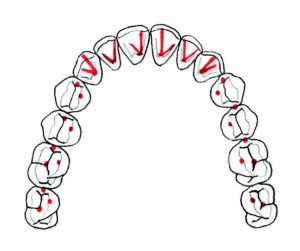Why might I need an Equilibration?
In short, you might need an equilibration if when biting down all your teeth aren’t making contact with equal force and at the same time while the jaw joint is in its proper anatomical position.
Why can that be a problem?
Unstable bites can lead to problems with the teeth, muscles that work the jaw and the jaw joint. Teeth can wear prematurely, fracture and become loose. The jaw muscles can become overworked and sore leading to headaches. In the jaw joint there is cartilage which can become displaced leading to jaw noises, altered jaw movements and pain.
One of the analogies we like to use is if the wheels on your car aren’t balanced, you can still drive the car, but over time the tires will wear out prematurely. Wear and tear to the car can occur, which in the long run is going to cost a lot more than just getting the tires balanced in the first place.
What is an occlusal equilibration?

Equilibration is the process of getting the bite balanced.
Equilibration is the corrective process to get the teeth to hit evenly when the jaw joints are seated in their correct position, but we’re not biting on all of our teeth
Our goal is to get all the teeth hitting evenly to distribute the bite forces equally to all of the teeth. The simplest way to do that, often times, is to perform an occlusal equilibration. Equilibration on properly selected patients is very predictable, minimally invasive and extremely successful.
An uneven bite is like a four-legged stool that wobbles a little bit.
To fix the wobbly stool, you use a piece of sandpaper, determine which leg is the longest one, and reduce that leg just enough so that all the legs are even and the stool is stable on the floor. We do the same thing with the teeth, except we have more legs to consider.
To learn more about the occlusal equilibration appointment, click here.


